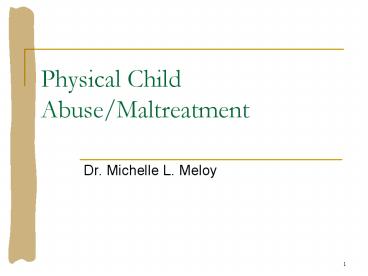Physical Child AbuseMaltreatment - PowerPoint PPT Presentation
1 / 15
Title:
Physical Child AbuseMaltreatment
Description:
Between 1962-1966 all states passed laws forbidding child abuse by parents. 1974 Congress passed Child Abuse & Prevention-Treatment Act ... – PowerPoint PPT presentation
Number of Views:200
Avg rating:3.0/5.0
Title: Physical Child AbuseMaltreatment
1
Physical Child Abuse/Maltreatment
- Dr. Michelle L. Meloy
2
Historical Perspectives of Child Abuse What
was...
- Arrests were likely only in cases of permanent
injury or death - Cultural heritage religious teachings
sanctioned corporal punishment - Legal notions of progeny as the property of
fathers - Spare the rod, spoil the child
- Honor thy father and mother
3
Historical Perspectives of Child AbuseWhat
was...
- Social movements in the 1800s/1900s resulted in
legal shifts to criminalize the behavior - Child abuse rediscovered in 1960s by pediatric
radiologists Battered Child Syndrome - BCS believed to be a cyclical pattern of physical
abuse perpetrated by parents who had also been
beaten as children - Typical victim Under 3 years, traumatic injuries
to head and limbs with claims that injuries were
caused by falling - Term was gradually replaced by child abuse or
child maltreatment
4
Criminalization Reporting Laws
- Between 1962-1966 all states passed laws
forbidding child abuse by parents - 1974 Congress passed Child Abuse
Prevention-Treatment Act - Because victims are often too young or vulnerable
to report the abuse, mandatory reporting laws now
exist in all 50 states - Heres an example of a local child abuse case
5
Criminalization Reporting Laws
- Child Neglect Ranges from abandonment to failure
to provide for childs basic needs in 3 areas
physical, emotional, educational - Physical Abuse Physical injury resulting from
punching, beating, kicking, biting, burning,
shaking or otherwise causing harm - Sexual Abuse Any sexual activity with a child or
exploitation into sex work or pornography - Emotional Abuse Care providers causing serious
emotional-cognitive-behavioral damage to child
6
Child Abuse The Numbers
- 2008 900,000 confirmed cases of child abuse
- Death resulted in 1,500 of these victims
- Shaken-baby syndrome affects between 1,200- 1,600
children every year - debate over shaken-baby syndrome
- As of Spring 2008 confirmed child abuse cases
- neglect/maltreatment 64
- physical abuse 16
- sexual abuse 9
- emotional abuse 7
7
Victim Facts
- Slightly over half (52) of child abuse victims
are female (48 male) - Slightly over half (53) of child abuse victims
are under the age of 7 - Children under the age of 4 are most likely to be
seriously injured or die as a result of injuries - 2008 CDC data suggests Blacks, American Indians
or Alaskan natives and Multiracial children are
overrepresented as victims
8
Risk factors for victimization
- Younger children (under 7)
- Children with disabilities
- Families that are socially emotionally isolated
- Substance abuse in family
- Undereducated parents
- Prior parental history of domestic violence
- Poverty
- Unemployment or underemployment
- Community violence
9
Risk factors for victimization
- Stressed disorganized family settings
- Young, single parents w/out biological
connections to child - Violence-prone socialization pro-violent
attitudes - Stress or depression among parents or caregivers
- Poor parent-child relationships and negative
interactions - Parental thoughts and emotions supporting
maltreatment behaviors
10
Risk Factors For Offending
- Age Younger parents
- Gender Mothers appear to be the perpetrators in
slightly more than half of reported cases - Familial Relationship Most offenders are
parents to the victim. Victimizations by
strangers are rare - Relationship status of parent Single parents
are over represented among abusers - Environmental factors High rates of poverty,
stress, cycle of violence characteristics
11
Low risk or preventive environments
- Family support
- Nurturing parents
- Stability in supportive and pro-social
relationships - Rules, monitoring and expectations of child
- Parental employment
- Adequate housing
- Access to health care and social services
- External community support
- Child abuse awareness and prevention program
12
Consequences of Child Abuse Snapshot
- Physical abuse as a child by parents - doubles
the odds of physical abuse as an adult - Direct costs 24 billion annually
- Indirect costs 69 billion annually
- Brain injuries
- Emotional problems
- Physical problems
- Sleeping disorders
- Panic attacks
- Stress disorders
- Crime
- Long-term effects
13
Consequences of Child Abuse Developmental
- Inability to control emotions or frequent
outbursts - Submissive behavior
- Academic difficulty
- Interpersonal difficulties
- Unusual eating or sleeping behaviors
- Aggressive or sexually provocative behavior
- Socially or emotionally inappropriate behavior
- Lack of response to affection
14
Consequences of Child AbuseCriminogenic
- Chances of being arrested as a juvenile increase
by 58 compared to non-abused children - Abused children are 28 more likely to be
arrested when they reach adulthood - Abused children are 30 more likely to be
arrested for a violent offense
15
Consequences of Child AbuseVictimization Repeats
- Victims of child physical abuse or child sexual
abuse are more likely to be physically or
sexually abused as adults































